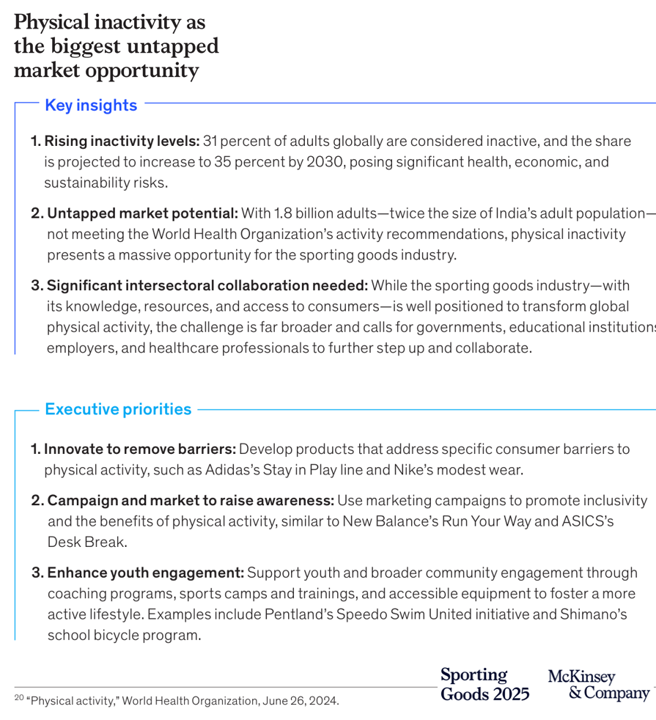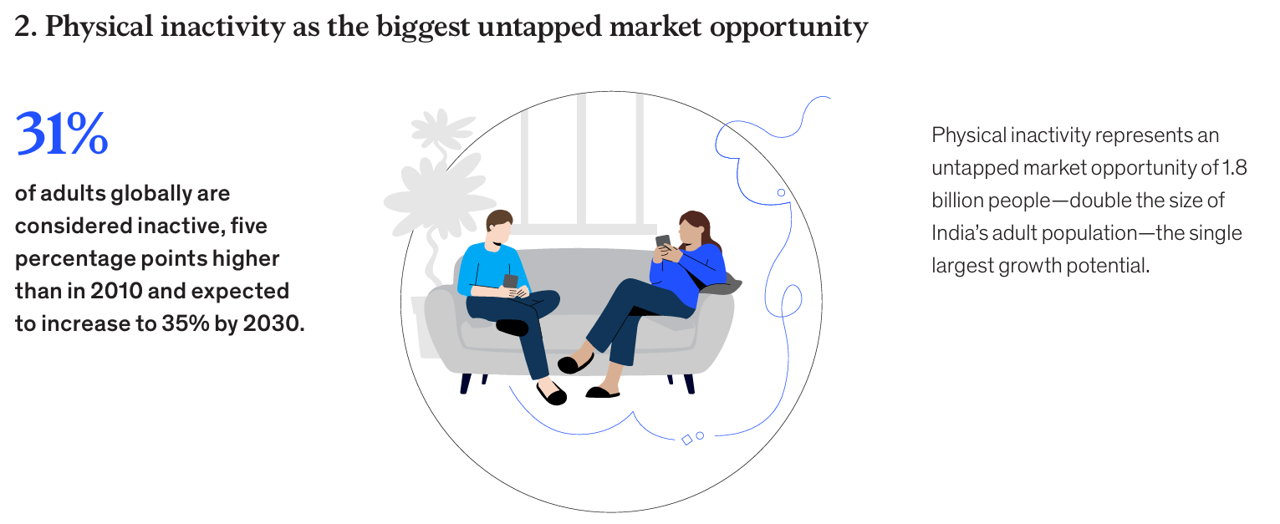McKinsey just published a detailed report into Sporting Goods 2025, which the firm calls a “new balancing act” that must turn uncertainty into opportunity.

The report is based on five key observations:
- Only a few sporting goods companies have expanded growth and margins since 2018 — and must “rethink the value chain” in the face of challenging geopolitical headwinds
- One-half of so-called “active consumers” say that fitness is a core element of their identity, with emotional connections to brands they purchase for the lifestyle
- Incumbent sporting goods companies are losing market share to challenger brands
- There is a blurring of live sports and entertainment, representing an opportunity to capture new consumers and grow loyalty and engagement (and revenue), and,
- Physical inactivity is the biggest untapped market opportunity — my favorite finding in this research with exciting implications for the larger health/care ecosystem and self-care for physical and social health benefits.

Here’s a snippet from the report on physical activity, noting that one-third of adults on the planet are considered inactive. This is 5 percentage points greater than in 2010, and expected to reach 35% by 2030.
McKinsey calculates this as an untapped market opportunity of 1.8 billion people, 2x greater than India’s adult population.
McKinsey calls for greater collaboration in and beyond the sporting goods industry, bringing together both public- and private-sector organizations to tap, motivate, and inspire this under-served market.
At the other end of the activity spectrum are consumers who self-define as “active,” with their fitness an integral part of their personal identity. These consumers relate to brands that support their physical fitness as loyal team members connected to larger community of like-minded active athletes.

Health Populi’s Hot Points: In the report, McKinsey points to the “boom of live sports” resulting in consumers’ post-pandemic yearning for in-person events. McKinsey believes that yearning can translate in consumers’ engagement with sporting goods companies who collaborate with live events in growing and popular sports segments. New stadiums are being built, McKinsey tracks, as multipurpose places that blend live sports, entertainment, and retail.
How about integrating well-being and health in these real estate projects?
As people continue to seek out “third spaces” beyond home and work/offices to expand hearts and minds, sports-oriented spaces can also cater to this consumer demand. How about book club meet-up spots to bolster social health, or movie programs featuring series that focus on health and medicine? Consider grocery store demo’s on healthy (and tasty!) food, or celebrating mocktails embracing healthy, creative ingredients.
Example: Fresh Take, which I covered here in Health Populi in 2023 as the grocery store + golf venue was coming together. Here’s a news story from the local Channel 6 station introducing the community to this new concept of retail grocery, fresh food (aka a “grocerant”) and a putting green embedded in the experience.
McKinsey suggests enhancing in-person and digital offerings (think: VR, for example), along with leveraging community resources such as gyms and fitness studios, yoga and Pilates, along with innovating retail spaces to engage consumers and drive foot traffic…..and sales.
On a larger scale, McKinsey’s global team asks us to take a look at the former Tsukiji fish market which was redeveloped into a $6.8 bn project to include a stadium, live events, trade shows, and a hub for commerce, leisure, and hospitality.
Whatever the size of the collaboration and project, the goal is to bring together like-minded consumers for social exercise, education (“info-tainment”), and commercial interests of sporting goods innovators and retailers.
We are inspired to further brainstorm opportunities for third spaces for sports, health and well-being bringing together community partners that, together, can be drivers of well-being for all who seek to be more active in mind, body, spirit, and health citizenship. The fact that some of the developments include food and opportunities to dine in groups is super-important and -impactful for social health….to counter the growing “eating alone” phenomenon I’ve been focusing on lately.
Since I’ve joined the pickleball community, I can see it now: a deli-sports concept called Dill Pickle(ball). Hey, it’s probably out there already with Chicken N Pickle (with locations in Arizona, Colorado, Indiana, Kansas, Missouri, Nebraska, Nevada, Oklahoma, and Texas), The Picklr (a national chain now in over 20 states). and the Crush Yard, a growing chain in the southern U.S…..among many others in this fastest-growing sport.





 I love sharing perspectives on what's shaping the future of health care, and appreciate the opportunity to be collaborating once again with Duke Corporate Education and a global client on 6th May. We'll be addressing some key pillars to consider in scenario planning such as growing consumerism in health care, technology (from AI to telehealth), climate change, and trust -- the key enabler for health engagement or dis-engagement and mis-information. I'm grateful to be affiliated with the corporate education provider
I love sharing perspectives on what's shaping the future of health care, and appreciate the opportunity to be collaborating once again with Duke Corporate Education and a global client on 6th May. We'll be addressing some key pillars to consider in scenario planning such as growing consumerism in health care, technology (from AI to telehealth), climate change, and trust -- the key enabler for health engagement or dis-engagement and mis-information. I'm grateful to be affiliated with the corporate education provider  Thank you FeedSpot for
Thank you FeedSpot for